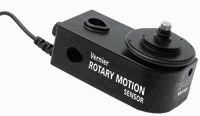 Rotary
Motion Sensor
Rotary
Motion SensorConserving Angular Momentum
Goals
- Gain experience with using RMS
- Test conservation of angular momentum
Materials
LabQuest
Rotary Motion Sensor (RMS)
Aluminum Disks
Procedure
- In General: You will set the main disk that’s on the Rotary Motion Sensor into motion. Begin monitoring the angular speed then drop the second disk onto the rotating one. The graph of Angular Velocity vs. Time can be used to investigate conservation.
- Plug the RMS Sensor with a main platter connected into one of the analog ports.
- Start the LabQuest. Use the default experiment setup that appears when you use the RMS Sensor, time-based for a length of 10 seconds.
- Start the main platter spinning. You will notice that spinning it one way will give you positive readings while spinning it the other gives negative readings.
- Start collecting data. After 3-4 seconds, drop the second platter gently onto the first. Stop the data collection after 3-4 more seconds have elapsed so you can do your analysis.
- If you have a third platter to use, tap the file cabinet icon to store the first run, then repeat the procedure with your new combination. For example, if you have a 3rd platter that’s the same as the first two, you can drop the 3rd one onto the combination of the first two, or drop two at once onto the main platter. Or if you have a 3rd platter that’s different, you can drop it onto the main platter. Try different combinations.
Analysis
- If needed, go to Graph > Show Graph > Graph 2 to show only the angular velocity graph.
- Using the stylus, determine the speed of the main platter just before the second platter was dropped and the speed afterwards.
- If the masses and sizes of the two platters are essentially the same, does your data support conservation of angular momentum? How does the data look if you use a second platter with a different mass than the main platter? Explain.
- As the platter was spinning before the second platter dropped, what happened to the angular velocity? Compare this with the graph after the drop. How do you explain the difference? What factors are at work to produce these results?
- Describe how you can use this experimental procedure to determine the moment of inertia (I) of an object.
Click here to download an MS Word version of this lab
Click here to download a pdf version of this lab
C.Bakken
6/2009